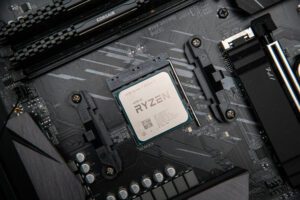To fix no signal on computer monitor, check cables and connections, ensure the display source is selected, and update the graphics driver if necessary. When your computer monitor displays no signal, that means it is unable to receive input from the computer’s graphics card.
This issue can occur for a variety of reasons, such as problems with cables and connections, incorrect display settings, or outdated graphics drivers. Resolving the no signal error can be a frustrating and time-consuming process, but understanding the most common causes and solutions can help you fix the problem quickly.
In this article, we will guide you through the steps to troubleshoot the no signal error and get your monitor working again.


Credit: www.youtube.com
Common Causes Of No Signal Error
Have you ever encountered a “no signal” error on your computer monitor? This issue can be frustrating, especially if you’re working on something important and suddenly your monitor displays a blank screen. There could be various reasons why you’re experiencing this error, and it’s essential to troubleshoot the problem as soon as possible.
Here are the common causes of “no signal” error and how to fix them:
Loose Connections And Cables
One of the most straightforward reasons for a “no signal” error is loose connections or cables. The monitor cable could be loose, or the cable might not be plugged in appropriately on either side of the connection. Here are a few steps to fix the issue:
-check both ends of the monitor cable and verify that it’s connected correctly.
-make sure the power cable and other cables are firmly in place.
-try using a different cable to see if it resolves the issue.
Damaged Cables, Adapters, Or Ports
If the cables and connections are correctly connected, the issue could be a damaged cable, adapter, or port. If you notice any visible damage, such as frayed cables or bent pins, it’s time to replace them. Here are a few steps to follow:
-inspect the cables, adapters, and ports for any signs of damage.
-replace any damaged cable, adapter, or port.
-ensure the cables and adapters are compatible with your monitor and computer.
Outdated Or Corrupted Drivers
Without proper drivers, your computer may not communicate with your monitor correctly. Sometimes outdated or corrupted drivers can cause a “no signal” error. Here are a few solutions to try:
-update your drivers by downloading the latest driver from the manufacturer’s website.
-uninstall the existing driver and reinstall it from scratch.
-reset the driver settings to the default.
Software And Hardware Conflicts
Sometimes software or hardware conflicts can cause a “no signal” error. For example, if your computer’s graphics card is not compatible with your monitor, you could receive this error. Here are a few steps you can take:
-check the compatibility of your monitor and graphics card.
-update the drivers and software.
-disconnect any additional hardware to see if it resolves the issue.
Power Supply Issues
The power supply could be another reason that you’re receiving the “no signal” error. It’s essential to ensure everything is powered correctly and sufficiently. Here are a few things you can do:
-check the power supply connection and verify it’s connected correctly.
-plug your monitor and computer into a different power outlet.
-use a different power cable to check if it resolves the issue.
Encountering a “no signal” error can be a frustrating experience, but it’s essential to stay calm and troubleshoot the issue. Follow these simple steps, and you’ll be back to work in no time!
Troubleshooting Steps
Resolving No Signal: A Guide To Fix Computer Monitor
The “no signal” error can be frustrating, especially when you need to work from your computer. Fortunately, there are a few steps you can take to resolve it.
Checking The Cables And Connections
The first troubleshooting step is to ensure that all cables and connections are firmly secured. If the cables are loose, they can cause the “no signal” error.
Here are the key points:
- Check that all cables are correctly plugged in and secure.
- Try unplugging and re-plugging all cables and connections.
- Ensure that the monitor and computer are properly connected.
Updating Drivers
Outdated or incorrect drivers can also cause the “no signal” error. Updating your drivers can help resolve this issue.
Here are the key points:
- Check the manufacturer’s website for driver updates.
- Find the correct model for your computer and download the latest drivers.
- Install the drivers and restart your computer.
Resolving Software And Hardware Conflicts
Occasionally, conflicts between software and hardware can lead to the “no signal” error. Resolving these conflicts can help.
Here are the key points:
- Check for any recent software installations that may be causing the issue.
- Uninstall any unnecessary or conflicting software and restart your computer.
- Investigate whether any hardware issues are causing the error.
Other Possible Causes Of No Signal Error
There are a few other reasons why you may be experiencing the “no signal” error.
Here are some key reasons:
- An outdated or damaged monitor may cause the error.
- A faulty graphics card may also be to blame.
- In rare cases, a virus may be causing the issue.
Remember to troubleshoot and test each potential solution before moving on to the next one.
By addressing these potential causes of the “no signal” error, you can get your computer monitor working correctly again without having to call a technician.
Advanced Solutions For No Signal Error
Advanced solutions for no signal error:
Resetting bios settings:
One solution to the no signal error on a computer monitor is to reset bios settings to their default values. To reset bios settings, follow these steps:
- Restart the computer.
- Press the appropriate key (usually f2, f10, or delete) to enter bios setup.
- Find the ‘reset to default’ or ‘reset bios’ option and select it.
- Save changes and exit bios.
Reinstalling operating system:
If resetting bios settings does not solve the no signal error, another solution is to reinstall the operating system. Keep in mind that this is a drastic solution and will erase all data from the computer, so it should only be used as a last resort.
Here’s how to do it:
- Back up all important data from your computer.
- Insert the installation media for the operating system and restart the computer.
- Press the appropriate key to enter the boot menu (usually f12) and select the installation media.
- Follow the instructions on the screen to reinstall the operating system.
Hiring a professional or manufacturer support:
If you have tried resetting bios settings and reinstalling the operating system, and the no signal error still persists, it may be time to get professional help. You can either hire a professional technician or contact the manufacturer’s support team.
Before doing so, make sure to check if your computer is still under warranty.
By following these advanced solutions, hopefully, you can tackle the no signal error on your computer monitor. However, if all else fails, don’t hesitate to seek professional assistance.
Frequently Asked Questions On How To Fix No Signal On Computer Monitor
How Do I Fix No Signal On My Computer Monitor?
Check the cable connection, change the input source, and restart your computer. If the problem persists, update video drivers or try a different monitor.
Why Isn’T My Monitor Showing Anything?
There may be a loose cable connection, the input source may be incorrect, or the video drivers may need updating. Try troubleshooting these issues first.
Can A Faulty Graphics Card Cause No Signal?
Yes, a faulty graphics card can cause no signal to display on your monitor. Try removing and reseating the graphics card, or replacing it if necessary.
Conclusion
After going through the tips and tricks mentioned in this article, fixing the no signal issue on your computer monitor should not be problematic anymore. From checking the cables to updating drivers, you have learned to address the common causes related to this problem.
Even though the issue may seem complex and daunting at first, stay calm and follow the steps one by one. In the end, it is worth your time and effort to have a smoothly functioning device. Remember to keep your device updated and regularly check for any hardware issues.
Additionally, you can seek professional help if the issue persists. We hope this article has been beneficial to you in solving the no signal problem. Happy computing!



